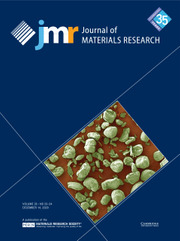Crossref Citations
This article has been cited by the following publications. This list is generated based on data provided by
Crossref.
Mattern, Norbert
Roth, Stefan
Kühn, Uta
Hofman, Matthias
Bauer, Hans-Dietrich
and
Eckert, Jürgen
2001.
Formation of Nanocrystals by Crystallisation of Zr-Al-Cu-Ni-Fe Metallic Glasses.
MATERIALS TRANSACTIONS,
Vol. 42,
Issue. 8,
p.
1509.
Kasai, M
Saida, J
Matsushita, M
Osuna, T
Matsubara, E
and
Inoue, A
2002.
Structure and crystallization of rapidly quenched Cu (Zr or Hf) Ti alloys containing nanocrystalline particles.
Journal of Physics: Condensed Matter,
Vol. 14,
Issue. 50,
p.
13867.
Saida, J.
Ishihara, S.
Kato, H.
Inoue, A.
and
Chen, H. S.
2002.
Suppression of quasicrystallization by nonlinear viscous flow in Zr–Al–Ni–Cu–Pd glassy alloys.
Applied Physics Letters,
Vol. 80,
Issue. 25,
p.
4708.
Saida, J
and
Inoue, A
2002.
Icosahedral quasicrystalline phase formation in Zr–Al–Ni–Cu glassy alloys by the addition of V, Nb and Ta.
Journal of Non-Crystalline Solids,
Vol. 312-314,
Issue. ,
p.
502.
Saida, J.
Matsushita, M.
and
Inoue, A.
2002.
Nano icosahedral quasicrystals in Zr-based glassy alloys.
Intermetallics,
Vol. 10,
Issue. 11-12,
p.
1089.
Sordelet, D.J
Rozhkova, E
Besser, M.F
and
Kramer, M.J
2002.
Formation of quasicrystals in Zr–Pd–(Cu) melt spun ribbons and mechanically milled powders.
Intermetallics,
Vol. 10,
Issue. 11-12,
p.
1233.
H$uuml$ttner, Bernd
2002.
Optical properties under exposure to ultrashort laser pulses.
Journal of Physics: Condensed Matter,
Vol. 14,
Issue. 26,
p.
6689.
Saida, J
Matsushita, M
and
Inoue, A
2002.
Transformation in the initial crystallization stage of Zr–Al–Ni–Cu glassy alloys made with low oxygen concentrations.
Journal of Non-Crystalline Solids,
Vol. 312-314,
Issue. ,
p.
617.
Sordelet, D. J.
Rozhkova, E.
Besser, M. F.
and
Kramer, M. J.
2002.
Synthesis route-dependent formation of quasicrystals in Zr70Pd30 and Zr70Pd20Cu10 amorphous alloys.
Applied Physics Letters,
Vol. 80,
Issue. 25,
p.
4735.
Stadnik, Z M
Rapp, $Ouml$
Srinivas, V
Saida, J
and
Inoue, A
2002.
M$ouml$ssbauer and transport studies of amorphous and icosahedral Zr-Ni-Cu-Ag-Al alloys.
Journal of Physics: Condensed Matter,
Vol. 14,
Issue. 27,
p.
6883.
Sherif El-Eskandarany, M.
Saida, J.
and
Inoue, A.
2003.
Structural and calorimetric evolutions of mechanically-induced solid-state devitrificated Zr60Ni25Al15 glassy alloy powder.
Acta Materialia,
Vol. 51,
Issue. 5,
p.
1481.
Saida, Junji
Matsubara, Eiichiro
and
Inoue, Akihisa
2003.
Nanoquasicrystallization in Metallic Glasses.
MATERIALS TRANSACTIONS,
Vol. 44,
Issue. 10,
p.
1971.
El-Eskandarany, M.Sherif
Saida, J.
and
Inoue, A.
2003.
Room-temperature mechanically induced solid-state devitrifications of glassy Zr65Al7.5Ni10Cu12.5Pd5 alloy powders.
Acta Materialia,
Vol. 51,
Issue. 15,
p.
4519.
Kramer, M. J.
and
Sordelet, D. J.
2003.
Metastable States During Devitrification of a Zr70Pd20Cu10 Metallic Glass.
MRS Proceedings,
Vol. 806,
Issue. ,
Ma, Chaoli
and
Inoue, Akihisa
2003.
Microstructure and Mechanical Properties of Cr, Mo, Fe, Ta Modified Pd-Ni-Cu-P Glassy Alloys Prepared by Copper-Mold Casting.
MATERIALS TRANSACTIONS,
Vol. 44,
Issue. 1,
p.
188.
Kramer, M. J.
and
Sordelet, D. J.
2003.
Metastable States During Devitrification of a Zr70Pd20Cu10 Metallic Glass.
MRS Proceedings,
Vol. 805,
Issue. ,
Kramer, M.J
Besser, M.F
Yang, N
Rozhkova, E
Sordelet, D.J
Zhang, Y
and
Lee, P.L
2003.
Devitrification studies of Zr–Pd and Zr–Pd–Cu metallic glasses.
Journal of Non-Crystalline Solids,
Vol. 317,
Issue. 1-2,
p.
62.
Kasai, Masayuki
Matsubara, Eiichiro
Saida, Junji
Nakayama, Masao
Uematsu, Katsuhito
Zhang, Tabo
and
Inoue, Akihisa
2004.
Crystallisation behaviour of Cu60Zr30Ti10 bulk glassy alloy.
Materials Science and Engineering: A,
Vol. 375-377,
Issue. ,
p.
744.
Sordelet, D.J.
Rozhkova, E.
Besser, M.F.
and
Kramer, M.J.
2004.
Meta-stable quasicrystal formation in vitrified and solid state synthesized amorphous Zr-based alloys.
Journal of Non-Crystalline Solids,
Vol. 334-335,
Issue. ,
p.
263.
Saida, Junji
Setyawan, Albertus Deny Heri
Kato, Hidemi
and
Inoue, Akihisa
2005.
Nanoscale multistep shear band formation by deformation-induced nanocrystallization in Zr-Al-Ni-Pd bulk metallic glass.
Applied Physics Letters,
Vol. 87,
Issue. 15,




